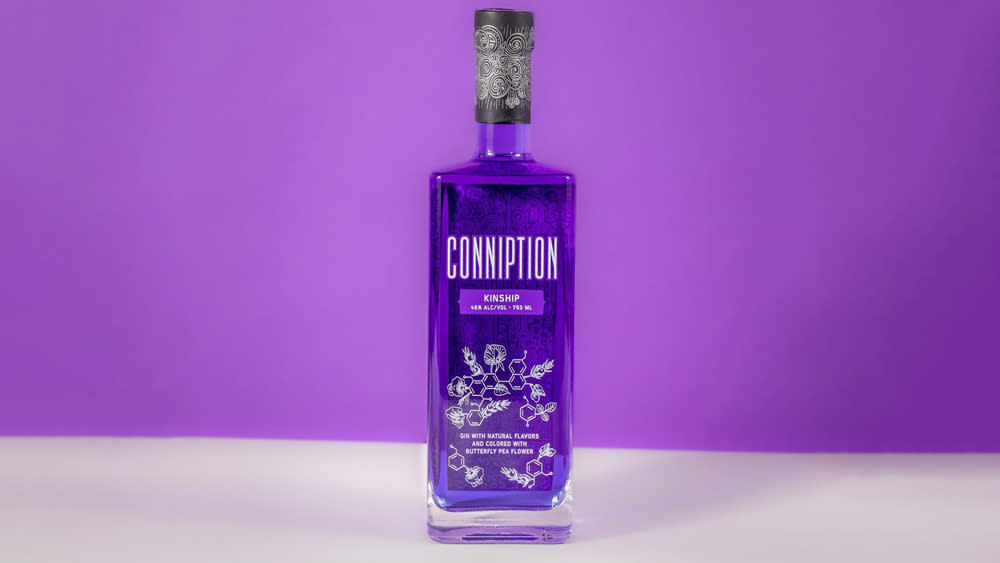Forget Millennial Pink. Distillers Are Turning Their Gin Purple Now.

If there are two of something, it could very well be a coincidence. But when three similar things have arrived, the signs are pointing to a trend in the making. Such is the case with purple gin, a small but growing category of this spirit that is usually clear as water. But the question remains—does the color affect the flavor, and are people buying it?
The latter remains to be seen as some of these gins are very new, and the former ultimately depends on what’s used to color the gin. The latest member of the purple party is the new Tamworth Garden Damson Plum Flavored Gin. This gin comes from the same New Hampshire distillery that brought you such spirits as the crab-flavored Crab Trapper, Eau de Musc which was infused with beaver gland oil and Bird of Courage which was essentially distilled with elements of a Thanksgiving dinner. The low-ABV (30 percent) gin is more of a magenta than a solid purple, but it still fits the bill. The color comes from the infusion of damson plums into the spirit, a practice that the distillery says dates back several centuries in the UK. “British traditions often made their way to New England when the land in Tamworth was first settled,” said founder Steven Grasse in a statement, “and our Damson Plum Gin is distilled in homage to those who first created the spirit during the 17th century.”
More from Robb Report
How to Make a White Lady, a Classic Gin Cocktail That's Even Better Than Your G&T
Black+Decker's New Cordless Cocktail Maker Can Mix More Than 40 Different Drinks
This New Gin Takes a Cue From the Whiskey World With Its Barrel Proof Bottling
Another recent release that would be useful for making a freaky looking Martini, if that’s your thing, is Conniption Kinship from Durham Distillery. This purple gin actually shifts colors as you mix it with other ingredients, changing from violet to blue or pink as you build a cocktail. To make the gin, two spirits are blended together—a botanical base vapor distilled with juniper, Indian coriander, angelica root, licorice root and dried bitter orange; and what is essentially a vodka cold distilled with other botanicals like cucumber and orange. Finally, the purple color comes via the infusion of butterfly pea flowers into the spirit.
Last spring, a similarly colored gin arrived from New Zealand called Scapegrace Black. Yes, the name indicates a black gin (although it presents almost like an extremely deep indigo), but the gin quickly changes to a violet or lavender color once you mix it with tonic or citrus. The core ingredient and source of the color is the same as Conniption Kinship, butterfly pea flowers that, along with a bevy of other botanicals, give the gin a distinct flavor profile.
Over the past few years a few other purple gins have entered the market as well, including Empress 1908 from Canada and Australia’s Ink Gin (both of which are made with butterfly pea flower), and JJ Whitley Violet Gin. Snoop Dogg’s Indoggo might appear to be a purple gin, but that’s the bottle and not the spirit, so as of this writing there’s still no celebrity-backed purple gin brand. The gins that utilize the butterfly pea flower as their color-changing ingredient are still really given most of their flavor from juniper and whatever particular botanical blend is used in production. But it does make these bottles stand out, and it can be a fun cocktail component. Still, the purists are likely to keep making their Martinis and gin and tonics with any number of clear London dry or new American gins, and save the purple expressions for playing around with.
Best of Robb Report
Why a Heritage Turkey Is the Best Thanksgiving Bird—and How to Get One
The 10 Best Wines to Pair With Steak, From Cabernet to Malbec
Sign up for Robb Report's Newsletter. For the latest news, follow us on Facebook, Twitter, and Instagram.

